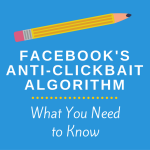Facebook is changing its news feed… and you’ll NEVER guess why!
Well, maybe you will guess. Facebook announced last week that it’ll be changing its news feed algorithm to punish clickbait headlines. Facebook employees waded through thousands of different headlines in order to categorize headlines that withhold information, or give a misleading expectation for the reader. They then used that information to create a system similar to email spam filters, but for clickbait headlines.
So, expect fewer videos promising that what happens next will blow your mind, or that you’ll cry every time.
Moving towards authentic communication
Why? According to Facebook, one of their news feed values is “to have authentic communication.” Clickbait, which often results in a quick click to the page, and then an immediate return to Facebook, just doesn’t cut it.
What does work? Let’s dig a little deeper into what “authentic communication” actually means. Facebook wants people to know what to expect when they’re clicking a link, and to have their expectations for the link match reality. We’ve all been there–the link headline promises that “When You Find Out What These Kids Are Jumping Into, Your Jaw Will Drop!” And when you click through, you realize that they’re jumping into… a swimming pool.
In fact, clickbait headlines are so persistent that there’s an entire Twitter feed dedicated to spoiling them. Clickbait “spoilers” and Facebook’s news feed switch both come from the same idea: people don’t want to click a link to find a disappointing answer to a misleadingly worded question.

This is also a further example of Facebook deprioritizing content from publishers in favor of a more personal, intimate news feed style. Facebook announced that it wants users’ news feeds to feel like real communication with friends, instead of a barrage of posts from organizations and companies. In order to achieve that, they tweaked their algorithm so that users see more posts from friends and family, and fewer from Pages.
What this means for your nonprofit organization
So what effect will this have on social sharing for nonprofit campaigns? Well, Facebook’s change happens to match up with the results of our own testing around Facebook headline best practices for advocacy campaigns. We’ve been helping nonprofits to test Facebook sharing language over the past few years, and we’ve also found that authentic communication is the way to go. For example, we’ve seen that using a Facebook headline that clearly indicates that a link is a petition (“Sign the Petition: Save the Whales” versus “Save the Whales”) actually leads to higher action rates when the link is shared. Your organization benefits when you’re clearly informing your supporters about what they can expect.
So if you want real Facebook users to see your organization’s content, it needs to be have an authentic voice and story that your supporters will respond to. The ShareProgress tools are one way to increase the impact of sharing by your supporters–they help you build a foundation of authentic, engaging social communication for your campaigns. As long as Facebook keeps prioritizing authentic communication, turning your supporters into advocates for your causes will continue to be a powerful way to reach new audiences.

Comments